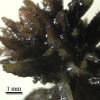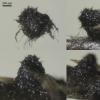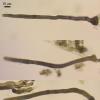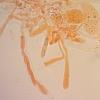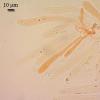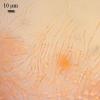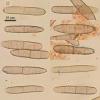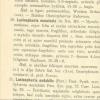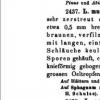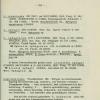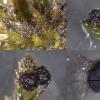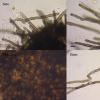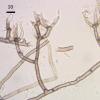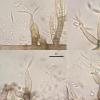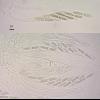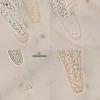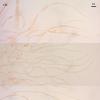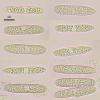
12-11-2025 09:25
 Viktorie Halasu
Viktorie Halasu
Hello, I need help with a pale terrestric Pseudom

11-11-2025 20:16
Bohan JiaHi, lastly I have found these tiny yellow decayin

09-11-2025 13:20
Hello.A tiny ascomycete, appearing as erupting gra

08-11-2025 00:29
 Francois Guay
Francois Guay
I found this species in Quebec, Canada, on herbace
Lasiosphaeria from sphagnum
Nina Filippova,
10-03-2013 19:02
Perithecia globose to pyriform, to 700 mk high, 500-600 mk broad, site among dense weft of brown hyphae on sphagnum branches; dark brown, almost black, upper part setose, base with abundant hyphae, walls firm; all plant (sphagnum) becoming black and firm to the touch. Asci cylindrical, to 200 long, 15-20 broad; paraphyses cylindrical, segmented, 2-3 broad; spores cylindrical, becoming brown in asci, with 1-3 septa, gututlate, 36 (31-41) x 7 (5,5-8,8) (N=20).
Covering densely sphagnum in one spot; S. balticum probably, in wet bog hollow.
Martin Bemmann,
10-03-2013 19:28
Martin Bemmann,
10-03-2013 19:50

Re : Lasiosphaeria from sphagnum
additional comment: Schröter describes the asci half as long then in your find and more narrow. The spores he observed are bent from the middle part. So maybe a different species as in the desription by DeNotaris/Saccardo where this feature is not mentioned. In the contrary the spores are described there as straight "rectis".
Best
Martin
Best
Martin
Alain GARDIENNET,
10-03-2013 20:20
Re : Lasiosphaeria from sphagnum
Döbbeler, in 1978 gave L. muscicola and :
L. sphagni DELACROIX, Bull. Soc. Mycol. France 6: 182
L. sphagni DELACROIX, Bull. Soc. Mycol. France 6: 182
(1890). -
Wirt: Sphagnum sp.
L. sphagnorum (CR.) SACCARDO, Syll. Fung. 2:201 (1883).
MOUTON, Bull.Soc. Roy. Bot. Belgique 25: 157 (1886).
SVRCEK, Ceska Mykol. 25: 56 (1971). = Sphaeria sphagnorum CR. in CROUAN & CROUAN,
Fl. Finist.
24 (1867).
Wirte: Sphagnum nemoreum SCOP. (sub S. acutifolium), S. subsecundum
NEES. S. teres (SCHIMP. ) ÄNGSTR. , Sphagnum sp.
Alain
Nina Filippova,
11-03-2013 09:55
Re : Lasiosphaeria from sphagnum
Thank you, Martin and Alain!
Now Andrew Miller reported me and he would be interesting in work with this specimen professionally, and i will send it to him. I will inform there about the results, as soon as they appear.
Now Andrew Miller reported me and he would be interesting in work with this specimen professionally, and i will send it to him. I will inform there about the results, as soon as they appear.
Nina Filippova,
13-07-2013 07:20
Marja Pennanen,
03-08-2014 15:01
Re : Lasiosphaeria from sphagnum
Hi Nina,
have you got the determination yet?
I have found this species for years on Sphagnum in wet, guite shadowed places and am very interested to know, what its is. This is not rare.
When you find it once, you will find it there every summer, if nothing dramatic happens in the surroundings.
Marja
have you got the determination yet?
I have found this species for years on Sphagnum in wet, guite shadowed places and am very interested to know, what its is. This is not rare.
When you find it once, you will find it there every summer, if nothing dramatic happens in the surroundings.
Marja
Georges Greiff,
24-04-2022 18:37
Re : Lasiosphaeria from sphagnum
Hello,
Although it has been many years since this was observed, I am interested in whether you were able to confirm this collection as L. muscicola.
To me, the lack of obvious bending in the spores seems to eliminate Hilberina (L.) sphagni and H. sphagnorum, but there is some uncertainty in the literature about the differences between H. sphagnorum and L. muscicola (Svre?k, 1971).
I have recently examined very similar material on Scorpidium, also in bog habitat, which also seems to correspond with L. muscicola.
Interesting that such distinctive species have so few documented observations on the internet that I can see...
All the best,
George
Although it has been many years since this was observed, I am interested in whether you were able to confirm this collection as L. muscicola.
To me, the lack of obvious bending in the spores seems to eliminate Hilberina (L.) sphagni and H. sphagnorum, but there is some uncertainty in the literature about the differences between H. sphagnorum and L. muscicola (Svre?k, 1971).
I have recently examined very similar material on Scorpidium, also in bog habitat, which also seems to correspond with L. muscicola.
Interesting that such distinctive species have so few documented observations on the internet that I can see...
All the best,
George

